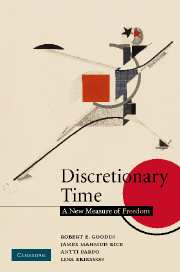Preface
Published online by Cambridge University Press: 28 October 2009
Summary
One thing leads to another, in scholarship as in life. The project reported here grows out of Goodin's earlier collaboration with Bruce Headey, Ruud Muffels and Henk-Jan Dirven on The Real Worlds of Welfare Capitalism. That book used a very different sort of data from ongoing ‘panels’ to examine the real impact of each of the three main types of welfare regimes on various standard indicators of social concern: poverty, equality, efficiency, social stability, social integration. In addition to all those standard indicators, we thought that we ought also try to assess their impact on people's ‘autonomy’, somehow construed.
We floundered searching for a good measure. Eventually we hit upon one that seemed particularly telling: a time-and-money measure of ‘combined resource autonomy’, representing the proportion of the population earning at least a poverty-level income and spending no more than the internationally agreed maximum of 40 hours a week in paid labour to do so.
The proportion of people failing that standard might be said to be in ‘time-or-money poverty’. In countries representing corporatist and social-democratic welfare regimes, that proportion was only a shade higher than the proportion in money poverty alone. But in the liberal US welfare regime, where money poverty was already twice as high as in the other two regimes, ‘time-and-money poverty’ was double that again – a whopping 35 per cent.
- Type
- Chapter
- Information
- Discretionary TimeA New Measure of Freedom, pp. xvii - xxPublisher: Cambridge University PressPrint publication year: 2008



